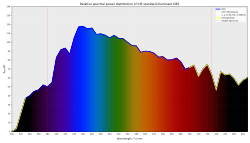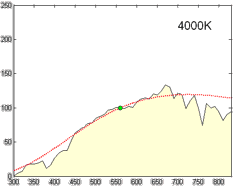Physics:Illuminant D65

CIE standard illuminant D65 (sometimes written D65[1][2]) is a commonly used standard illuminant defined by the International Commission on Illumination (CIE).[3] It is part of the D series of illuminants that try to portray standard illumination conditions at open-air in different parts of the world.
D65 corresponds roughly to the average midday light in Western Europe / Northern Europe (comprising both direct sunlight and the light diffused by a clear sky), hence it is also called a daylight illuminant. As any standard illuminant is represented as a table of averaged spectrophotometric data, any light source which statistically has the same relative spectral power distribution (SPD) can be considered a D65 light source. There are no actual D65 light sources, only simulators. The quality of a simulator can be assessed with the CIE metamerism index.[4][5]
The CIE positions D65 as the standard daylight illuminant:
[D65] is intended to represent average daylight and has a correlated colour temperature of approximately 6500 K. CIE standard illuminant D65 should be used in all colorimetric calculations requiring representative daylight, unless there are specific reasons for using a different illuminant. Variations in the relative spectral power distribution of daylight are known to occur, particularly in the ultraviolet spectral region, as a function of season, time of day, and geographic location.—ISO 10526:1999/CIE S005/E-1998, CIE Standard Illuminants for Colorimetry[6]

History
The CIE introduced three standard illuminants in 1931:
- A: Incandescent bulb simulator
- B: Daylight simulator (direct)
- C: Daylight simulator (shade)
B and C were derived from A by using liquid filters. The approximation to real light this provided was found lacking, so in 1967 the CIE accepted a proposal by Judd, MacAdam, and Wyszecki for a new series of daylight simulators, bearing the initial D.[7][8][9]
Definition
D65 is a tabulated SPD in increments of 5 nm from 300 nm to 830 nm, using linear interpolation on the original data binned at 10 nm.[10][11] The CIE recommends using linear interpolation of the component SPDs, S0, S1, and S2 if the application requires greater precision, but there is a proposal to use spline interpolation instead.[12]
Using the standard 2° observer, the CIE 1931 color space chromaticity coordinates of D65 are[13]
and the XYZ tristimulus values (normalized to Y = 100), are
For the supplementary 10° observer,[citation needed]
and the corresponding XYZ tristimulus values are
Since D65 represents white light, its coordinates are also a white point, corresponding to a correlated color temperature of 6504 K. Rec. 709, used in HDTV systems, truncates the CIE 1931 coordinates to x=0.3127, y=0.329.
Color temperature
The name D65 suggests that the correlated color temperature (CCT) should be 6500 K, while in truth it is closer to 6504 K. This discrepancy is due to the scientific community's 1968 revision of the constants in Planck's law after the definition of the illuminant.[3] This shifted the Planckian locus, affecting all CCTs, which are calculated by finding the nearest point on the locus to the white point. The same discrepancy applies to all illuminants in the D series—D50, D55, D65, D75—and can be "rectified" by multiplying the nominal color temperature by ; for example for D65.
References
- ↑ Noboru, Ohta; Robertson, Alan R. (2005). "3.9: Standard and Supplementary Illuminants". Colorimetry. Wiley. pp. 92–96. doi:10.1002/0470094745.ch3. ISBN 978-0-470-09472-3.
- ↑ Poynton, Charles A. (2003). Digital Video and HDTV: Algorithms and Interfaces. Morgan Kaufmann. p. 224. ISBN 978-1-55860-792-7. https://books.google.com/books?id=ra1lcAwgvq4C&dq=The+CIE+D+illuminants+are+properly+denoted+with+a+two-digit++subscript.&pg=RA1-PA224. "The CIE D illuminants are properly denoted with a two-digit subscript."
- ↑ 3.0 3.1 Schanda, János (2007). "3. CIE Colorimetry". Colorimetry: Understanding the CIE System. Wiley. pp. 25–78. doi:10.1002/9780470175637.ch3. ISBN 978-0-470-04904-4. "In 1967 the International Practical Temperature Scale, 1948, amended 1960 was in use. With that temperature scale c2 [=hc/kB] was 1.438×10−2m·K. In 1968, the International Practical Temperature Scale changed the value of c2 to 1.4388×10−2 m·K. Because of this fact the CCT of a daylight phase of T K on the 1948/1960 scale changed to 1.4388/1.4380×T, thus D65 with its ‘‘nominal CCT’’ has now a CCT of approximately 6504 K, and this temperature has to be set into the Equations (3.17) and (3.18) to get to the SPD as defined in 1967."
- ↑ CIE Technical Report (1999). A Method for Assessing the Quality of Daylight Simulators for Colorimetry. Paris: Bureau central de la CIE. ISBN 978-92-9034-051-5. http://www.cie.co.at/publ/abst/51-2-99.html. "A method is provided for evaluating the suitability of a test source as a simulator of CIE Standard Illuminants D55, D65, or D75. The Supplement, prepared in 1999, adds the CIE Illuminant D50 to the line of illuminants where the method can be applied to. For each of these standard illuminants, spectral radiance factor data are supplied for five pairs of nonfluorescent samples that are metameric matches. The colorimetric differences of the five pairs are computed for the test illuminant; the average of these differences is taken as the visible range metamerism index and is used as a measure of the quality of the test illuminant as a simulator for nonfluorescent samples. For fluorescent samples, the quality is further assessed in terms of an ultraviolet range metamerism index, defined as the average of the colorimetric differences computed with the test illuminant for three further pairs of samples, each pair consisting of a fluorescent and a nonfluorescent sample which are metameric under the standard illuminant."
- ↑ Lam, Yuk-Ming; Xin, John H. (August 2002). "Evaluation of the quality of different D65 simulators for visual assessment". Color Research & Application 27 (4): 243–251. doi:10.1002/col.10061.
- ↑ "CIE Standard Illuminants for Colorimetry". CIE. 1999. http://www.cie.co.at/publ/abst/s005.html.
- ↑ Judd, Deane B.; MacAdam, David L; Wyszecki, Günter (August 1964). "Spectral Distribution of Typical Daylight as a Function of Correlated Color Temperature". JOSA 54 (8): 1031–1040. doi:10.1364/JOSA.54.001031.
- ↑ Wyszecki, Günter (February 1968). "Recent Agreements Reached by the Colorimetry Committee of the Commission Internationale de l'Eclairage". JOSA 58 (2): 290–292. doi:10.1364/JOSA.58.000290.
- ↑ Committee E-1.3.1 (Colorimetry) (June 19–28, 1967). "Proceedings of the 16th session". Washington, D.C. Paris: CIE.
- ↑ "Relative SPD of D65, 300–780nm in 5nm increments.". CIE. http://www.cie.co.at/publ/abst/datatables15_2004/std65.txt.
- ↑ Relative SPD of D65 , 300–830nm in 1nm increments. Derived by linear interpolation of the 5nm table.
- ↑ Kránicz, Balázs; Schanda, János (August 2000). "Re-evaluation of daylight spectral distributions". Color Research & Application 25 (4): 250–259. doi:10.1002/1520-6378(200008)25:4<250::AID-COL5>3.0.CO;2-D. http://citeseer.ist.psu.edu/282652.html. "Later the S0(λ), S1(λ) and S2(λ) functions have been linearly interpolated at 5 nm steps and for even finer step-size also a linear interpolation has been recommended".
- ↑ Schanda, János (2007). "3. CIE Colorimetry". in Schanda, János. Colorimetry: understanding the CIE system. John Wiley & Sons. Appendix A, p. 74.
External links
 |

